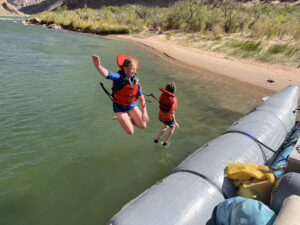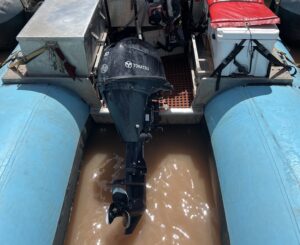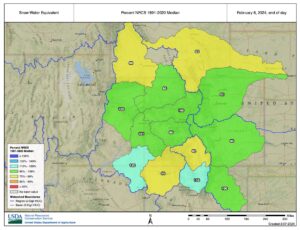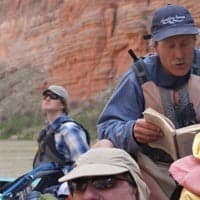Basic Grand Canyon Geology
In a Grand Canyon Raft Time Machine
It can be said that a Grand Canyon rafting trip is the best way to travel through time. The Colorado River has cut a “layer cake” of geology so to speak. Each geological rock layer of the Grand Canyon is a piece of the puzzle of the history of the Earth. Each layer contains clues into what kind of environment was present when the layer was being deposited. As well as the plants and animals that were living during this chapter of time.
Imagine if we had a real time machine! How awesome would it be to take our Grand Canyon raft back in time. We could witness first hand, chapters of the Earth’s history, and the processes that led to the formation of the Grand Canyon we know today.
How did the Grand Canyon Form?
Deposition, Uplift, Downcutting, and Erosion
“Dude, The Grand Canyon Rocks!” The common response is “Of course it does!” But DUDE is an easy mnemonic for remembering the processes that formed the Grand Canyon we love today. It is interesting that as studied as the Grand Canyon is, there is still some mystery to exactly how and when it formed. Geologists do agree Deposition, Uplift, Downcutting, and Erosion were major factors in forming the Grand Canyon.
What are the Geological Rock Layers of the Grand Canyon?
A simple mnemonic to remember the majority of the Paleozoic Rock Layers in Grand Canyon is: Know The Canyon’s History Study Some Rocks Tellingly Made By Time
Grand Canyon Rock Layers
Grand Canyon Geology-Traveling Through Time the Same Way a Grand Canyon Raft Would on the Colorado River
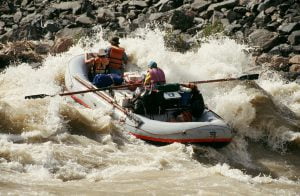
Grand Canyon Paleozoic Rock Layers
The Paleozoic Era began with the Cambrian explosion of marine life 541 million years ago and ended 252 million years ago with the end-Permian extinction. This era contains(from youngest to oldest) the following Grand Canyon Geologic Rock Layers: Kaibab Limestone, Toroweap Formation, Coconino Sandstone, Hermit Shale, Supai Formation, Surprise Canyon Formation, Redwall Limestone, Temple Butte Limestone, Muav Limestone, Bright Angel Shale, and Tapeats Sandstone.
Kaibab Limestone

Our rafting time machine is set to 270 million years ago. This takes us back to the Permian Period of the Paleozoic Era. Our Grand Canyon raft transforms into a submarine. Looking outside the windows of the submarine we can see the sea floor and the light from the sun above. It is a marine environment, our depth finder says we are about 80 feet down in a clear ocean. Fish and Sharks swim outside the window. Along the ocean floor shellfish, sponges, and seaweed dot the landscape. Crinoids sway with the ocean currents. East of the submarine the water gets shallower and eventually give way to land.
The present day Kaibab Limestone forms a cliff in the Grand Canyon. It is a limestone composed of the shells of the sea creatures that lived and died during its formation.
Toroweap Formation
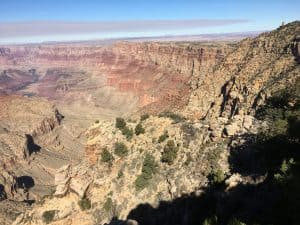
This time our rafting time machine is set to somewhere between 273-270 million years ago. Still in the Permian Period. Most likely we will need the submarine for our exploration of this spot 273 million years ago. However, it is likely that the water is shallow, possibly land locked from the ocean. The Toroweap formation contains muddy limestone, dolomite, sandstone, gypsum and halite. This suggests that the sea was retreating, and this area was close enough to shore that fine sediment from rivers was clouding up the water. The gypsum and halite suggest that lakes of sea water may have become supersaturated, allowing the minerals to precipitate. Fossils that have been found in the Toroweap Formation include brachiopods, bryozoans, crinoid, rugose corals, bivalves, gastropods, and cephalopods. The fossils suggest that there was ocean here for some of the deposition period of the Toroweep Formation. In summary, depending on when our time machine visited the Toroweap Deposition period would determine what we saw. During the deposition of the Toroweap Formation there were periods of ocean, shallow marine and desert environments.
The present day Toroweap Formation generally forms a slope. This is because of the softer rock layers of shale and mudstone. It separates the Kaibab Limestone from the Coconino Sandstone.
Coconino Sandstone

The time machine will need wheels for this trip. The dial on the time machine is set to the Permian Period somewhere between 275-273 million years ago. When we arrive, the time machine has transformed into a “dune buggy,” big sand dunes dominate the landscape. The sand dunes have been formed in a way that suggests the wind usually blows from North to South. The landscape in some ways is similar to the desert environment that we came from. Scorpions, millipedes, and spiders scurry across the sand dunes as we approach them. Off in the distance we are thrilled to see a dimetrodon! A dimetrodon is probably the best known non-mammalian synapsids. Dimetrodons are often mistaken for dinosaurs because of their looks and big sail, but they became extinct 60 million years before dinosaurs evolved and their DNA is closer to that of a human than it is to any reptile alive or dead.
The present day Coconino Sandstone layer of Grand Canyon forms an imposing cliff that is light pink in color. Upon closer examination cross bedding is visible. Well preserved tracks can be found throughout the layer.
Hermit Shale
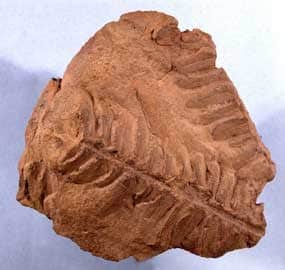
To visit the depositional environment of the Hermit Shale we will have to travel back 285 million years. We will be able to float our rafting time machine on an ancient river system. The semi-arid climate has contributed to the river banks filled with drought-adapted seed ferns, horsetails, small pines, and ginkgos. Large dragonflies buzz by the raft. The atmosphere has a higher oxygen content than present day earth(35% vs 21%). It is possible during a flood that our slow, meandering river can switch paths. Swampy areas can be found where the river has abandoned its old channel.
Iron oxide is responsible for the dark red hue of the Hermit Shale. The layer is made up of shale, siltstone, mudstone, and fine grained sandstone. Because the layer is soft ,it erodes easily, and usually forms a slope.
Supai Formation
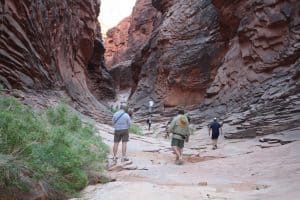
The Supai Formation in Grand Canyon has been divided into 4 sub-layers with a geologic unconformity between each: Watahomigi Formation, Manakacha Formation, Wescogame Formation, and Esplanade Sandstone. The entire formation was deposited in the Pennsylvanian and Permian Periods. The entire period of deposition of the Supai Formation would cover about 30 million years from 315 MYA to 285 MYA. We will time jump around in the Supai Formation in our time machine so we can get a better idea of what was happening.
Esplanade Sandstone
Setting our time machine to 290 million years ago brings to the time period of deposition for the Esplanade Sandstone. Geologists believe the Esplanade Sandstone was deposited largely in an estuarine environment. Our rafting time machine traveled back in time, and ended up on a large river carrying loads of ancestral rocky sediment into the ocean. Looking west the sun was setting over the Ocean.
Wescogame Formation
During the latter part of the Pennsylvanian Time Period the Uncompahgre Uplift caused the Ancestral Rocky Mountains to rise. This resulted in streams and rivers carrying sediment from these mountains. Rising sea levels led to the deposition of this sediment as part of the Wescogame Formation in the Grand Canyon. Our rafting time machine was set to travel back 300 million years ago and ended up transforming into a submarine to explore the ocean floor. Marine life was abundant. The Honaker Trail Formation in Canyonlands National Park was being deposited at the same time.
Manakacha Formation
Time traveling 8 million years further in the past puts us at 308 million years ago in the Pennsylvanian. We are floating on our Grand Canyon Raft Time Machine out in the open ocean.
Watahomigi Formation
Last stop on our time travels through the Supai Formation is 315 million years ago in the early Pennsylvanian Period. Looking outside our rafting time machine we are floating in a basin of water. The ocean has receded since our last stop during the deposition of the Manakacha Formation. There are rivers flowing into this basin bringing fine sediment and sand into it.
Summary of the Supai Formation
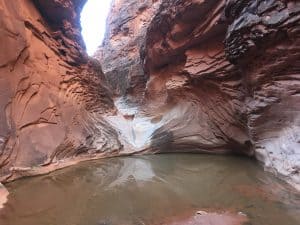
The Supai Formation is mostly formed by shale with some limestone and capped by sandstone. Limestone becomes more prevalent in the Western Grand Canyon leading one to hypothesize this area was more of a marine environment. Further East, a large river system brought ancestral rocky mountain sediment into the ancient ocean. The layer is rich in red color and forms a series of blocky steps, ledges, and slopes along the Colorado River in the Grand Canyon. Many fossils have been found in the Supai Layer including reptiles, amphibians, and terrestrial plants in the eastern part of the formation, and marine fossils further west.

Surprise Canyon Formation
The Surprise Canyon Formation was deposited during the late Mississippian Period(360 to 318 Million Years Ago). The layer is sandwiched between the Redwall Limestone and the Esplanade of the Supai Formation. Its depositional environment was most likely a shallow marine environment, with riverine and estuarine deposits preserved in the Surprise Canyon Formation. The formation can be found in ancient valleys that were formed at the top of the Redwall Limestone. There are a vast amount of fossils preserved in the Surprise Canyon Formation including: dental and dermal parts of ancient sharks, bryozoans, brachiopods, echinoderms, mollusks, and trilobites.
The Surprise Canyon Formation is probably the hardest layer to see of the Paleozoic Grand Canyon rock layers. Lenses of the layer can be found at the top of the Redwall Limestone. The Surprise Canyon Formation contains clastic and calcareous sedimentry rocks. Clastic sedimentary rocks are made up of pieces of other pre-existing rocks. Calcareous sedimentary rocks are mostly composed of calcium carbonate, in other words, containing lime or being chalky.
Taking the Rafting Time Machine back to 358 Million years ago we would be floating on top of a sea that was regressing. The estuaries were filled with marine life. Putting on scuba gear we could swim with early sharks and see trilobites. Imagine the underwater photos.
Redwall Limestone

During the Mississippian Period(360 t0 318 Million Years ago), what would become part of the Grand Canyon was under an ocean. This period of carbonate deposition lasted for approximately 40 million years. During this period the sea environment was both shallow and deep. We will need to transform our time machine from a raft into a submarine to explore the ocean floor. Brachiopods, corals, echinoderms, and bryozoans are abundant outside the windows of the submarine. Upon searching we find multiple “orthocone,” or straight shelled nautiloids. Nautiloids are a type of cephalopod. These nautiloids add chambers to their shell as they grown bigger. Over time their shell grows large, creating a large cone shaped shell. These cephalopods are relatives of modern day octopus, squid, cuttlefish, and nautilus. Nautiloids were marauders of the Mississippian Sea, and were ferocious predators.
The Redwall Limestone is an easily distinguished layer of rock in the Grand Canyon. This rock layer is responsible for vertical cliffs nearly 500 feet high. In the Grand Canyon the rock is generally stained red from the rocks layers above it.
Temple Butte Limestone
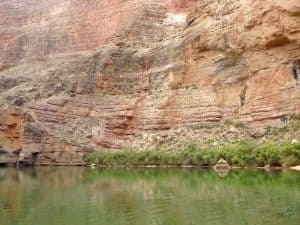
The Temple Butte Limestone was formed during the Devonian Period(460-318 Million Years ago). Traveling back to the Devonian Period of time, our rafting time machine would once again float upon an ocean. The western part of the Grand Canyon was inundated by ocean, while further East ocean water dwindled into estuaries over mud flats. An estuary is the tidal mouth of a large river, where the tide meets the stream.
Two animal groups began to colonize the land during the Devonian Period, terrestrial arthropods and tetrapods. The oceans were home to ammonites, echinoderms, corals, and crinoids. In addition, many new fish species developed during the Devonian time period.
Before the ocean rose these mud flats were home to slow meandering rivers. As the oceans rose, the river beds of these meandering rivers were home to the deposition of limestone. This deposit is Temple Butte Limestone. The Temple Butte Limestone can be hard to differentiate from the Redwall Limestone and the Muav Limestone, but to the trained eye it is easily distinguished. The Temple Butte Limestone has a slightly different color and texture. In many places it is exposed as a half circle shape. The modern Grand Canyon has cut through these Devonian meandering river channels. This has allowed river runners to see cross sections of the Temple Butte Limestone exposed near the Marble Canyon Damsite and Buck Farm Canyon.
Muav Limestone
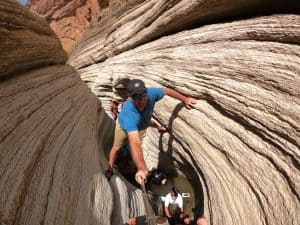
The Muav Limestone was deposited during the latter part of the Cambrian Period(505 Million Years Ago). It was formed in a deep sea environment when all life on Earth was ocean dwelling. No plants or animals had evolved on land yet. In the book Ancient Landscapes of the Colorado Plateau by Wayne Ranney and Ron Blakey, the terrestrial environment is described as being similar to “Mars.” Our time machine raft would float on top of the ocean. Looking through binoculars eastward, a barren landscape could be seen as far as the eyes could see. There are not many fossils preserved in the Muav Limestone. A few brachiopods have been found. Brachiopod fossils look similar to the fan shaped shells you find at the beach in modern times
Bright Angel Shale
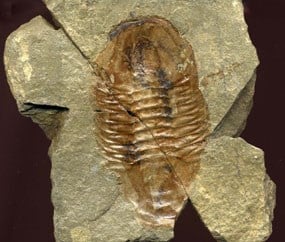
The Bright Angel Shale was deposited in a shallow marine environment, just off shore, during the the Cambrian Period(506 Million Years ago). This rock layer is rich with iron and other elements giving it stunning colors. The layer erodes easily and is made up of very fine sediment brought in by rivers and streams. One of the most interesting creatures to emerge during the Cambrian Period is the Trilobite. For the deposition of the Bright Angel Shale we will definitely want to transform the Time Machine into a submarine to explore the ocean floor and the trilobites. Trilobites dominated the Sea Floor from the Cambrian Period all the way until the end of the Paleozoic Period 252 Million Years ago. These creature were survivors. They are the relatives of modern day insects, crabs, and spiders. There were over 20,000 species of trilobites that lived during their existence. Trilobites caught food by filter feeding, scavenging, predation, and even developed mutually beneficial relationships with bacteria. In Time Machine it would be amazing to see if it was really true that Trilobites may have been social. Some evidence suggests that they migrated in groups across the ocean floor. It is believed that trilobites evolved to deal with predators. Some types of trilobites curled up, others developed thorny spines, many burrowed underneath the sand and mud to effectively hide.
Today the Bright Angel Shale is one of the more stunning layers. Its purple and green colors stand out amongst all of the red hues of the Grand Canyon. It is also worth noting that the Bright Angel plays a big role in the shaping of Grand Canyon. Because it is such a soft layer it tends to erode easily. This results in the rock layers above falling down as it erodes away. The Tonto Platform is because of the Bright Angel Shale. It is also believed that through geologic history big landslides have occurred due to the softness of the Bright Angels Shale. It is also theorized by some geologists that the next huge landslide that potentially could block the Colorado River will happen where the Bright Angel Shale is exposed at river leve
Tapeats Sandstone

The Tapeats Sandstone was formed during the Cambrian Period(508 Million Years Ago). During the Great Cambrian Transgression, the ocean transgressed from West to East, covering the modern Grand Canyon. This transgression caused the ages of the Cambrian Rocks of the same type to be slightly different ages. For example the Tapeats sandstone in the Western part of Grand Canyon is older than the Tapeats Sandstone deposited in the Eastern Grand Canyon.
The Tapeats Sandstone is one of the best rocks to take a “power nap” on. It creates flat ledges along the Colorado River in places like Blacktail Canyon. Also in Blacktail Canyon one can look up close at the Grand Canyon Great Unconformity. An unconformity geologically speaking is a gap in the depositional rock layer record that may indicate episodes of crustal deformation, erosion, and sea level variations. Put simply, an unconformity is a break in time in an otherwise continuous rock record. The Great Unconformity in Grand Canyon occurs where the Tapeats Sandstone was deposited directly on top of the Proterozoic Crystalline Rocks. This unconformity spans a gap of over a billion years of time. This unconformity can be seen in a variety of locations in Grand Canyon, but having the chance to span the Great Unconformity in the shady Tapeats Sandstone of Blacktail Canyon is special. Deep time is something that is extremely hard to comprehend for the human mind, but it is also astoundingly powerful.
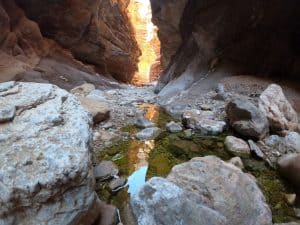
Time traveling back to the beginning of the Cambrian Transgression and start of the deposition of the Tapeats Sandstone might be pretty awesome. We could travel back in time in our rafting time machine and find a small cove to anchor off shore. A short swim to shore and a small hike back to the open ocean would put us in the vacation spot of our dreams. Imagine a huge beach stretching for miles, big waves crashing on the shore, the sun disappearing over the horizon, and not a single piece of vegetation, animal, or human. The beach would be ours and the surf would be amazing! Unfortunately there would be no palm trees for shade.
Sixtymile Formation
The Sixtymile Formation is composed of a thin layer of sediment. It is only found in a few places in the Chuar Valley. The upper part of the formation is believed to be a stream deposit. The middle part of the formation accumulated in standing water. The lower part of the layer contains landslide deposits as well as lake deposits of siltstone and sandstone.
According to the newly released The Grand Canyon Trail of Time Companion book by Karl Karlstrom and Laura Crossey, the Sixtymile Formation’s age is formally changing from 650 million years old to a new age of 510 million years. This will move the Sixtymile Formation out of Grand Canyon Supergroup. It will now be part of the Tonto Group.
Proterozoic Rock Layers in Grand Canyon that can be seen from the Colorado River(from youngest to oldest):
The Grand Canyon Supergroup
- Chuar Group
- Galeros Formation
- Kwagunt Formation
- Nakoweep Formation
- Unkar Group(1200-1100 Million Years Ago)
- Cardenas Lava
- Dox Formation
- Shinumo Quartzite
- Hakatai Shale
- Bass Limestone
Grand Canyon Precambrian Crystalline Rocks
Proterozoic Era Geologic Rock Layers( 2500 to 541 million year ago)
The Proterozoic is an era in geological time spanning the time from the appearance of oxygen in Earth’s atmosphere to just before the proliferation of complex life on Earth. Grand Canyon geology explores the following rock groups(from youngest to oldest) during the Proterozoic: The Grand Canyon Supergroup and Grand Canyon Precambrian Crystalline Rocks.
The Grand Canyon Supergroup contains(From youngest to oldest)The Sixty Mile Formation, Chuar Group, Nankoweep Formation, and the Unkar Group. While these layers are all found within Grand Canyon, we are only going to briefly explore the Sixtymile Formation, Chuar Group, and Nankoweep Formation. These geologic groups and layers are not seen or only briefly seen from the Colorado River.
More time will be spent looking at the Unkar Group which is composed of the the Cardenas Basalt, Dox Formation, Shinumo Quartzite, Hakatai Shale, and Bass Limestone.
Chuar Group
This group is composed of the Kwagunt Formation, the Galeros Formation, and the Nankoweep Formation. The Chuar Group contains about 85% mudrock with interbedded dolomite and sandstone. The group is rich in fossils of stromatolites, microfossils, and architarchs. The depositional environment included shallow marine and low energy waters where mud and organic material could accumulate.
Nankoweep Formation
The Neoproterzoic Nankoweep Formation consists of thin red beds of sandstones, siltstones, and mudrocks. The layers is only visible sporadically through the Grand Canyon. One such place is across from Tanner Canyon at the Tanner Graben. It is unclear what the depositional environment of the Nankoweep Formation was, but it may have been deposited in shallow slow moving waters. The Nankoweep Formation used to be considered its own rock unit, but is now considered part of the Chuar Group.
Cardenas Basalt
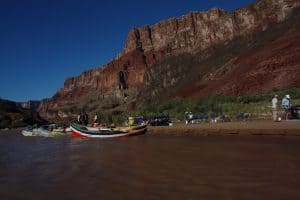
From the vantage point of the Colorado River, the Cardenas Basalt most often presents itself as cliff forming lava flows. The dark basaltic cliffs are laced with dikes and sills and interbedded with sandstone. The layer was formed because of rifting of the ancient supercontinent of Rodinia. This supercontinent formed about 1.1 billion years ago. This rifting resulted in the outpouring of Cardenas Basalt.
Taking the Time Machine back to look at Earth during this time would be incredibly exciting. The Cardenas Basalt was one small part of mass volcano eruptions across the Earth. It is believed that the diabase sills found in Grand Canyon were essentially “feeding,” the Cardenas Basalt. There is no place where the diabase sills can be directly connected to the Cardenas Basalt, but their chemistries and age are the same.
Dox Formation
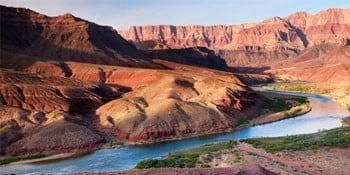
Sandstone, Shale and Mudstone form the Dox Formation. The layer is predominantly red in color. It is common to find mud cracks and ripple marks in the Dox Formation. These features suggest our Rafting Time Machine would likely be floating on marine, coastal, or estuarine waters. We may also find ourselves stuck on fluvial mud flats.
The fluvial mud flats are similar to what we encounter, when our rafts enter Lake Powell or Lake Mead. In the case of Lake Powell and Lake Mead the reservoirs were full until the late 1990s. As the Colorado River was slowed, by the headwaters of the reservoirs, the sediment settled out of the river onto the lake bottom.
Due to the extended drought of the 2000s the reservoir levels have steadily dropped. This drop resulted in the Colorado River cutting through its previously deposited sediment. Just before the muddy river enters the blue green water of the reservoirs it fans out. The braided channels are shallow and span hundreds of yards. The mud flats are barren and vast.
Shinumo Quartzite

The Shinumo Quartzite has a complex past. It was deposited at different times by an ancient river system, nearshore marine environment, coastal tidal, and supratidal flats. Depending on when we visited the deposition of the Shinumo Quartzite would determine what we could see from our Grand Canyon Raft Time Machine.
The difference between sandstone and quartz is in whether the individual sand grains are separate or have been recrystallized to the point where the grains become tightly interlocked. In the Shinumo Quartzite the grains are interlocked. The Shinumo Quartzite is a harder rock than regular sandstone.
Hakatai Shale
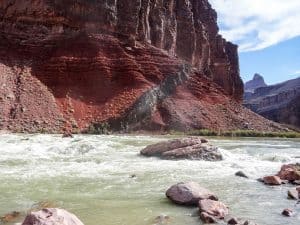
The Hakatai Shale is a brightly colored rock layer situated between the Shinumo Quartzite and the Bass Limestone. It is first seen along the Colorado River just above Hance Rapid. Most of the layer was deposited in a marginal marine environment. This is supported by the mudstones and shales found within the formation. The array of bright colors found in the Hakatai Shale are the result of the oxidation of iron-bearing minerals. Cross-beds, salt crystal casts, and cracks suggest the climate was really dry during the Hakatai Shale deposition.
Our time spent in the Grand Canyon Raft Time Machine during the deposition of the Hakatai Shale would be spent on slow moving, shallow water.
Bass Limestone
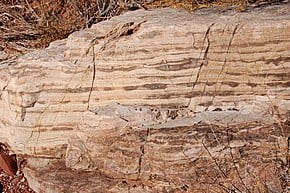
The Bass Limestone layer is composed of white to grey limestone mixed with a small amount of shale. The layer is significant because it is the oldest rock layer in Grand Canyon to contain a fossil record. The Stramatolite fossils present what primitive life looked like before the Cambrian explosion. Stramatolites are layered sedimentary features that are created by Cyanobacteria. Cyanobacteria are primitive bacteria that use the sun for fuel. Microbial mats were created by the microorganisms cementing sand and other rocky materials. These mats build up over time, layer upon layer. The fossilized stramatolites can be found in all kinds of different shapes depending how the microbial mats were shaped.

Stramatolites dominated the shallow seas of the Bass Limestone. Today, stramatolites are isolated to a few locations around the world where other organisms will not outcompete them or consume them.
From our Grand Canyon Raft Time Machine we would be able to see the stramatolites a few feet down, in the clear water of the Bass Sea. The round mats of microbial life would dominate the waters.
Another way to see this interesting life form would be to visit the Great Salt Lake in present time. About 300 miles North of the Grand Canyon is the Great Salt Lake. The Great Salt Lake is a basin filled lake with no exit point. The lake is much saltier than the ocean and is dominated today by Brine Shrimp and Stramatolites. In fact, the Great Salt Lake is ideal for Stramatolites, and is home to some of the most extensive reefs of living stramatolites on Earth. The hypersaline environment has no organisms to graze, browse, burrow, or bore into them.
Asbestos in Grand Canyon

At the contact point of the Bass Limestone and igneous diabase sill, Grand Canyon Asbestos deposits are found. These chrysotile asbestos deposits are of the contact metamorphic type that occur in magnesium-bearing Mesoproterozoic dolomites and limestones altered by basaltic sills. Chrysotile is formed by the limestone reacting with silica bearing fluids, heated by the basalt intrusions. Asbestos is known today to cause cancer, but in the late 1800s and early 1900s it was used for applications included fire-retardant coatings, concrete, bricks, pipes and fireplace cement, heat-, fire-, and acid-resistant gaskets, pipe insulation, ceiling insulation, fireproof drywall, flooring, roofing, lawn furniture and drywall joint compound.
John Hance and William Bass both attempted to mine asbestos in the Grand Canyon. They built trails and camps, and put an incredible amount of effort into mining. Both men eventually gave up the toils of mining for tourism. The trails they built for mining turned out to be perfect for taking tourists into the Grand Canyon.
Grand Canyon Precambrian Crystalline Rocks
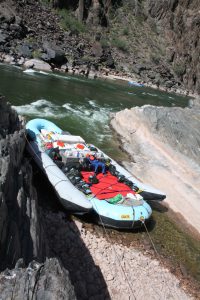
In the inner gorges of the Grand Canyon are the oldest rocks. These are the basement rocks of the Grand Canyon. The Grand Canyon Metamorphic suite includes the Vishnu Schist(altered sandstone and shale), Brahma Schist(Metamorphosed Basalt), and the Rama Schist(altered rhyolite). The Metamorphic schists and Zoroaster Granite Intrusions form the Grand Canyon Suite.
Before 1.75 Billion years ago the continental crust that would eventually make up the Colorado Plateau and Grand Canyon did not exist. Then an ancient island chain slid Northwest toward North America. Mud, Sand, and Lava from ancient volcanos accumulated in the basin between the island chain and North America. As the island chain moved closer to the continent and eventually collided with it, the buried deposits were deformed, squeezed, and folded. These rocks were also subjected to enormous amounts of heat and pressure deep in the Earth. These rocks were metamorphosed into schist, gneiss, and amphibolite.
These rocks were heated and “cemented” to the basement of North America. At “midcrustal levels” the rocks did not become hot enough to entirely melt. Deeper in the crust the rocks completely melted due to heat and pressure. These magma pockets rose from the depths and filled in cracks and fractures in the metamorphic rock. This combination of the lighter colored igneous rock and darker metamorphic rock has created an artistic array of colors, folds, and textures. A mountain building event and erosion eventually led to these Precambrian Crystalline Rocks returning to the surface.
It would be fun to take our Grand Canyon Raft Time Machine back to the Proterozoic. Imagine floating in the ocean between the continent and the island chain. Knowing that 1.75 Billion years in the future we would be rafting the Colorado River through the Grand Canyon, and deciphering the Earth’s history through the rock layers and Grand Canyon geology left behind.

